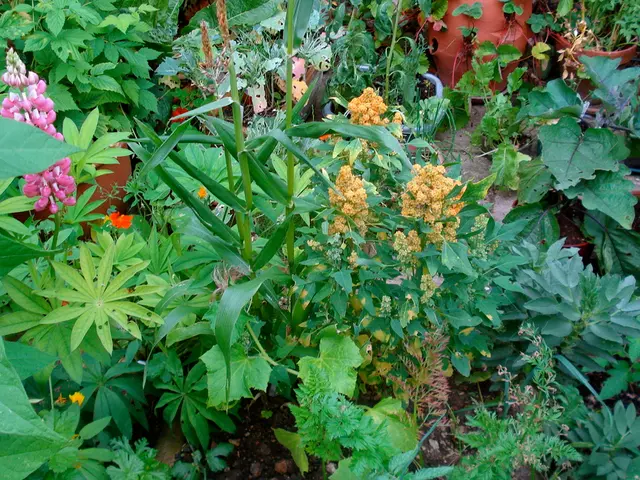Exploring Soil pH Adjustments Without Harming Vegetation
In the realm of gardening, understanding the chemical makeup of the soil is crucial for nurturing healthy and vibrant plants. Soil test results provide valuable insights into the fertility of the soil and what nutrients are present or may be needed for optimal growth.
These reports list the amount of macronutrients such as nitrogen (N), phosphorus (P), and potassium (K); secondary macronutrients like sulfur (S), calcium (Ca), and magnesium (Mg); and micronutrients such as copper (Cu), iron (Fe), manganese (Mn), zinc (Zn), boron (B), chloride (Cl), nickel (Ni), and molybdenum (Mo) in the soil.
However, while many of these micronutrients are reported, their levels do not currently affect fertilizer recommendations, with the exception of zinc (Zn).
The pH level of the soil, on the other hand, profoundly influences nutrient availability, microbial activity, and ultimately, plant growth. The pH scale shows a range of numbers from 0 to 14, with 7 being neutral. Most plants will thrive in a pH range from 6.0 to 7.5.
Soil pH test results indicate the acidity or alkalinity of soil. A pH below 7 is acidic, while a pH above 7 is alkaline. Most plants prefer slightly acidic to neutral soils, typically around pH 6.0 to 7.0. This range maximizes nutrient availability and microbial activity, allowing essential minerals to be accessible for uptake.
Acid-loving plants, such as blueberries, azaleas, and hydrangeas, thrive at lower pH levels (approximately 4.1 to 5.0). Acidic soils can increase the availability of certain nutrients like aluminum (which affects hydrangea bloom color), but may be deficient in calcium, magnesium, and molybdenum.
Plants tolerant or preferring alkaline soils, such as mock orange and chicory, still require care because high pH can reduce the availability of nutrients like iron, copper, zinc, and boron. Alkaline soils can also cause nutrient lockout and salt buildup, which harms roots and nutrient uptake.
For lawns and turfgrasses, an ideal soil pH is usually 6.0 to 7.0. Acidic soil below this range can cause phosphorus, calcium, and magnesium deficiencies and aluminum toxicity, while alkaline soil can lead to iron and manganese deficiencies and salinity problems.
For container or soilless growing media, recommended pH ranges differ by type. Bark-based mixes prefer a pH of 5.0 to 6.5, peat-based mixes 5.3 to 6.5, while most vegetables and herbs do best around pH 6.0 to 7.0.
Adjusting soil pH helps ensure nutrient availability, supports beneficial microbes, and promotes healthy plant growth tailored to the needs of different plants. If the pH is too high or too low, it can be toxic to plants. To adjust the pH, use lime to raise pH (reduce acidity) if your soil is too acidic, or use sulfur or acidifying agents to lower pH if your soil is too alkaline.
In addition to pH, soil test results may also provide information on other soil characteristics such as organic matter (OM) content, soluble salts (salinity), and cation exchange capacity (CEC). Testing a soil sample is the first step to understanding the chemical makeup of the soil and how it affects plant growth.
It is recommended to test soil pH every 3 to 5 years, or whenever a new garden bed is planted, a new location is moved to, or a new plant variety with specific pH needs is grown. Other soil testing methods include using a home test kit, sending a sample to a lab, or trying a DIY method with baking soda and vinegar.
Sources: [1] Penn State Extension. (2021). Soil Testing. Retrieved from https://extension.psu.edu/soil-testing [2] Cornell University Cooperative Extension. (2021). Soil Testing. Retrieved from https://ag.umass.edu/soil-nutrient-management/soil-testing [3] University of California Agriculture and Natural Resources. (2021). Soil Testing. Retrieved from https://ucanr.edu/sites/Soils/Soil_sampling/ [4] University of Florida IFAS Extension. (2021). Soil Testing. Retrieved from https://edis.ifas.ufl.edu/topic_soil_testing [5] Iowa State University Extension and Outreach. (2021). Soil Testing. Retrieved from https://www.extension.iastate.edu/soiltest/soil-testing-basics/
Transitioning from gardening to home-and-garden improvements, it's essential to understand the pH level of the soil. Soil pH test results indicate the acidity or alkalinity of soil and impact nutrient availability, microbial activity, and ultimately, plant growth. Home test kits, sending a sample to a lab, or DIY methods using baking soda and vinegar can help determine the soil pH level, which should be adjusted to ensure optimal home-and-garden lifestyle by promoting healthy plant growth and supporting beneficial microbes.






